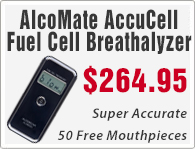 By Devin Powell
By Devin Powell
Inside Science News Service
The sensors that allow a breathalyzer to spot alcohol on the breath of a drunk driver are now being installed in a Florida hospital to monitor how often nurses wash their hands.
Hospitals may soon be on the alert for careful hand-washing practices. As of October 2008, a list of "hospital-acquired conditions" -- those that a hospital could have prevented with better practices, such as hand-washing -- can disqualify a hospital for Medicare coverage of the costs of treating the conditions. Infections like mediastinitis, a preventable complication that sometimes follows heart surgery, are on the list of disqualifying conditions, and several antibiotic -resistant bacteria are slated to be considered in the future.
"People in infection control all know how costly hospital-acquired infections are, but those dollar signs don't seem to move hospital administrators," said Maryanne McGuckin, president of McGuckin Methods International and a senior fellow at Thomas Jefferson Medical College.
The money may be hard to provide, but getting an infection can be easy. An area of skin the size of a fingernail can contain as many as four billion colonies of bacteria, and nurses can pick up large amounts of foreign microorganisms when touching patients or hospital equipment (especially wet surfaces). During a typical day at work, a nurse may wash his or her hands more than a hundred times, following the guidelines published by the Centers for Disease Control and Prevention (CDC) and the World Health Organization. This hand washing has been shown to cut the spread of infectious bacteria transmitted directly or on the surface of medical devices like catheters.
Despite the importance of soap and water, a recent study of a few hundred U.S. hospitals showed that only about half of all hospital workers comply with the guidelines.
To achieve greater compliance, Richard Melker, an anesthesiology professor at the University of Florida College of Medicine, has designed a sensor system that tracks hand washing, reminds nurses to do so, and tells patients whether their nurses have washed their hands.The technology, called Hygreen, is designed to curb the spread of hospital infections by improving the hygiene of healthcare workers.
Melker has installed small sensors near every sink and antiseptic dispenser in the Neuro Intensive Care Unit of Shandsat the UF Medical Center. When a nurse cleans his or her hands, a small fan sucks in the fumes. The breathalzyer sensors behind the fan detect alcohol in the vapors -- which is a key component of hospital soaps and waterless antiseptics.
The sensor then sends a message to a badge worn by the nurse, where an LED bulb turns from red to green for a minute and a half after a hand washing. This gives patients a straightforward way to tell if a nurse has washed his or her hands just before visiting them, as dictated by guidelines. "Our slogan is 'green is clean,'" said Melker.
Mounted on every bed in the ICU is another sensor that notices the approach of a nurse. A red badge that comes within eight feet of one of these bed sensors will vibrate three times, reminding the nurse with dirty hands to turn around and clean them. "Sometimes healthcare workers are so focused on fixing a problem that they just inadvertently forget; this gives them a private signal, a feedback that people respond very positively to," said Christine Pearson, director of Hospital Infection Control at Shands.
Some of the nurses approached for this small-scale trial were apprehensive about this "big brother" approach to hand washing. But those who chose to participate, according to Melker, appreciate the buzzing reminders.
"I do wash my hands more often," said Carrie McGirr, a nurse at Shands. "It's a fairly simple process to learn."
According to the CDC, better hand washing practices could cut the number of cases of antibiotic-resistant superbugs like MRSA (methicillin-resistant Staphylococcus aureus)by 30 percent because these bacteria are easily washed off or killed on hands with antiseptics but very difficult to treat with antibiotics once inside a patient.
With hospitals increasingly footing the bill for these complications, Melker hopes to deploy the sensors initially in the part of the hospital where people are most vulnerable to infections: intensive-care units, chemotherapy wards, "any places that have immunocompromised patients," said Melder.
Enforcement of hand washing is currently done by bringing in observers who monitor nurses or by measuring the amount of soap consumed in a given time to spot problematic areas of a hospital. "We've tried buttons, we've tried posters ... but if you don't routinely change them, people get used to them and they just become wallpaper," said Christine Pearson.
The biggest challenge for a technology like HyGreen will be its cost, saidMcGuckin. "I've been doing this for 30 years ... there's a lot of tech that comes out, and it just never goes anywhere," she said.
"Technology has a role, but it's not going to be the total answer," said McGuckin. She recommends a variety of approaches, the most important being to encourage patients to take a more active role in checking that their local hospitals and healthcare attendants are washing their hands.




